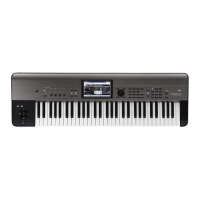Program mode
8
Note: System exclusive messages are not Tone Adjust
parameters; they are linked to the actual value. For example,
if a slider in the display is assigned to control filter
resonance, and you move this slider while recording to the
sequencer, the slider movement will be recorded, but the
change in filter resonance will not be recorded. This means
that if you later reassign the Tone Adjust parameter to
control LFO1 Speed, playing back the sequencer will cause
the LFO speed (not the filter resonance) to change.
Interaction between Tone Adjust and MIDI CCs
A number of the Common Tone Adjust parameters can
affect parameters which are also modulated by dedicated
MIDI CCs. The specific CC numbers are noted in the
descriptions for the individual Tone Adjust parameters. For
more information, please see “Tone Adjust Parameters” on
page 10.
Tone Adjust and the CCs work independently. It’s possible,
for instance, for Tone Adjust to reduce the value of a
parameter, and then for a CC to increase it again.
Tone Adjust scales the parameter first, and then the CC
scales the result of the Tone Adjust.
0–7a: Program Select & Tempo
Bank (Bank Select) [A...F, GM, g(1)...g(9), g(d)]
Program Select [A...F: 000…127, GM, g(1)...g(9),
g(d): 001…128]
(Tempo) [040.00...300.00, EXT]
This area displays information about the program selected
for editing: the program bank/number/ name, and the
tempo used to control the arpeggiator etc. For more
information, please see “0–1a: Program Select” on page 2.
0–7b: Selected parameter information
Selected parameter information
This status line shows detailed, read‐only information about
the currently selected Tone Adjust parameter.
Control [SW1...8, SL1...8]
This is the controller in the display to which the Tone Adjust
parameter is assigned.
SW: Switch
SL: Slider
Assignment
This shows the full name of the parameter assigned to the
controller. You can change this using the Assign parameter,
below.
Value
This shows the current value of the parameter. The range of
values will vary depending on the parameter assigned to the
control.
Type [Rel, Abs, Meta]
This shows the type of parameter, which relates to how edits
to the parameter are adjusted and saved. For more
information, please see “Absolute (Abs), Relative (Rel), Meta
parameter” on page 7.
Stored Value
This shows the original value of the parameter, before the
effects of Tone Adjust. It applies only to Tone Adjust
parameters which control a single Program parameter.
If you un‐assign a Relative parameter from a control, it will
revert to this value.
0–7c: Tone Adjust
Here, you can assign Tone Adjust parameters to switches
and sliders in the display.
Switches 1...8
Tone Adjust switches in the display act a little differently
than sliders.
When a switch is assigned to a Relative parameter, or an
Absolute parameter with more than two states:
Switch On = On Value (see below)
Switch Off = the Program’s stored value
When a switch is assigned to a two‐state Absolute
parameter, such as Hold, the switch status directly reflects
the parameter value:
Switch On = On
Switch Off = Off
Assign
This lets you assign a Tone Adjust parameter to the
displayed switch. For a full list of the available choices,
please see “Common Tone Adjust Parameters” and “Tone
Adjust Parameters” below.
On Value [Depends on parameter]
The parameter is set to this value when the switch is On.
When the switch is assigned to a two‐state Absolute
parameter, such as Hold, this will always be the same as the
Switch Status (see below).
Switch Status [Off, On]
This simply shows whether the switch is On or Off.
Sliders 1...8
Assign
This lets you assign a Tone Adjust parameter to the
displayed slider. For a full list of the available choices, please
see “Common Tone Adjust Parameters” and “Tone Adjust
Parameters” below.
Control Assignment Value Stored ValueType
Assign
Value

